Why Buying the Right Product Matters
Have you ever bought something online — maybe a kitchen gadget, a tech accessory, or even a skincare product — only to realize later it wasn’t what you expected?
Maybe it broke after a week.
Maybe it didn’t look like the pictures.
Or maybe it just didn’t solve the problem you thought it would.
If that sounds familiar, you’re not alone.
Shopping today is easier than ever, but buying the right thing — the one that truly fits your needs and lasts — is trickier than it’s ever been. We live in an age of choice overload. Hundreds of brands, thousands of reviews, millions of ads — all trying to convince you that their product is “the best.”
And when everything looks great online, how can you really tell what’s worth your money?
This guide was written to help you answer exactly that question.
Why this guide exists
I’ve seen too many people buy impulsively — from friends who spent $200 on a gadget they never used, to shoppers who bought “cheap deals” that turned into expensive regrets. Most of these mistakes didn’t happen because people were careless; they happened because they didn’t know what to look for.
We all want a good deal, but a “good deal” isn’t just about price. It’s about value — the right balance of cost, quality, and usefulness.
When you understand what makes a product good for you, you stop buying based on fear of missing out (FOMO) or marketing tricks. You start buying with confidence.
That’s what this guide will teach you.
What you’ll learn here
Over the next several sections, we’ll go step by step through the process of becoming a smart buyer — whether you’re shopping online or in-store. You’ll learn:
- How to understand your own needs before even looking at products.
- The key specifications and features that really matter (and which ones don’t).
- How to compare brands and recognize when a price is too good to be true.
- The right way to read customer reviews — and how to spot fake ones.
- Simple ways to buy safely online, from payment methods to seller verification.
- And finally, how to maintain your product so it lasts longer and gives you real value for money.
Whether you’re buying a laptop, a vacuum cleaner, a blender, or even a pair of shoes — the principles are the same. Once you know how to think like an informed buyer, you’ll make better decisions in every category.
The truth about online shopping
Online shopping has changed how we buy — but it’s also changed how we get misled.
A five-star rating doesn’t always mean a great product.
A “limited-time sale” might not actually end soon.
And a cheap price tag might hide poor materials, no warranty, or shady sellers.
The internet gives us access to everything — but also to misinformation.
That’s why the smartest shoppers today aren’t the ones who spend the least — they’re the ones who know how to evaluate.
Think of this guide as your roadmap. You don’t need to be a tech expert or a product reviewer. You just need a clear method for checking what matters before you hit “Add to Cart.”
How this guide is structured
This isn’t a quick “Top 5 things to check” list. It’s a complete buying education — designed for anyone who wants to understand how to choose right the first time.
Each section will walk you through a practical step:
- Understanding your needs
- Knowing key specs
- Comparing product types
- Checking quality
- Evaluating brands
- Reading reviews
- Analyzing prices
- Buying safely
- Maintaining your purchase
- Avoiding common mistakes
At the end, you’ll find a buying checklist and FAQ section — so even if you’re short on time, you can still skim and shop smarter.
A mindset shift: from impulse to intention
Here’s the biggest secret of all:
Smart buying isn’t about memorizing specs — it’s about slowing down.
When you pause before purchasing, when you ask the right questions, and when you learn to balance emotion with logic — that’s when you stop wasting money and start investing wisely.
Because every purchase is more than a transaction. It’s a reflection of how you make choices — and how much you value your time, comfort, and peace of mind.
So as you read this guide, don’t just think about the next thing you want to buy.
Think about the kind of buyer you want to become.
Let’s begin
In the next section, we’ll start with the foundation: understanding your own needs before you buy anything.
Because if you don’t know exactly what you need, no amount of research or reviews will save you from buying the wrong thing.
Step 1 – Understand Your Needs Before You Buy
Before you even open a shopping app or search Google for “best [product name],” stop for a moment.
Ask yourself one simple but powerful question:
“What problem am I really trying to solve?”
That question is where smart buying begins.
Many people skip this step. They jump straight to comparing prices or reading reviews, without understanding what they truly need. And that’s why they end up disappointed — not because the product was bad, but because it was wrong for them.
Let’s break this down carefully.

1. Define the problem, not the product
Every product is a solution to something — but what is that something in your case?
For example:
- You don’t buy a vacuum cleaner because you love machines. You buy it because you want a clean house with less effort.
- You don’t buy a smartwatch because it’s trendy. You buy it because you want to track your health, stay organized, or simply stop checking your phone all day.
- You don’t buy an expensive blender just to blend. You buy it because you want to eat healthier or make smoothies fast before work.
When you focus on the problem you’re solving, you’ll see the product differently.
You’ll stop being impressed by fancy features and start asking,
“Does this actually help me solve my problem efficiently?”
2. Know who will use the product
Is this something you’re buying for yourself, your family, your kids, or your parents?
Each user has different needs — and that completely changes what you should look for.
For example:
- A beginner camera user doesn’t need 4K recording with 20 buttons. They need a simple, lightweight model with auto mode and clear instructions.
- A product for children should be safe, durable, and easy to clean.
- A gift for elderly parents should focus on simplicity — big buttons, easy charging, clear display.
Tip: When in doubt, imagine a real scenario of using it every day. If you can’t picture how you (or the person using it) will actually interact with it, you probably haven’t understood your need well enough yet.
3. Identify your “must-haves” vs. “nice-to-haves”
This is one of the biggest mistakes people make — mixing up what they want with what they need.
A “must-have” is something the product absolutely must include to serve your purpose.
A “nice-to-have” is something extra that’s cool, but not essential.
For example:
- For headphones, must-have = good sound and comfort; nice-to-have = noise cancellation or wireless charging.
- For kitchen appliances, must-have = durability and safety; nice-to-have = extra modes or smart app control.
- For laptops, must-have = performance and reliability; nice-to-have = touch screen or backlit keyboard.
Make a small list before you buy.
If a product doesn’t meet all your “must-haves,” it doesn’t matter how many discounts or features it has — it’s not the right one.
4. Think about where and how often you’ll use it
A product that’s perfect for one person can be a waste for another — just because their usage context is different.
Ask yourself:
- Will I use this every day or occasionally?
- Do I need it to be portable or stay in one place?
- Will it face heavy use or just light use?
- Do I have space to store it properly?
Example:
If you only bake once a month, you don’t need a professional $400 bread maker.
But if you cook every day, a better-quality model will save you time and frustration in the long run.
👉 The goal is to match usage frequency with product durability and price.
Daily use = invest more.
Occasional use = go for something reliable but simple.
5. Set a realistic budget (and understand what “value” means)
Let’s be honest — price is always a factor.
But “cheap” and “good value” are not the same thing.
Instead of asking, “What’s the lowest price I can find?”, ask:
“What’s the best value for my needs?”
Value means how much benefit you get from every dollar spent.
A $40 product that breaks in a month has zero value.
A $120 product that lasts three years and saves time every day has great value.
Try this small mindset shift:
When you see a higher price, don’t reject it immediately.
Ask what you’re paying for. Is it better materials? Longer warranty? Better support?
Sometimes, paying 20% more means saving 80% of future problems.
6. Consider your environment and lifestyle
Your lifestyle shapes what kind of product will make sense for you.
For example:
- Live in a small apartment? → Choose compact, multi-functional products.
- Have pets or kids? → Prioritize easy cleaning and safety.
- Travel often? → Lightweight, foldable, or rechargeable options will make life easier.
- Prefer minimalism? → Fewer features, higher quality.
Your environment influences your satisfaction more than you think.
Many people regret purchases not because the product failed — but because it simply didn’t fit their lifestyle.
7. Ask yourself “Will I actually use it?”
This question can save you hundreds of dollars every year.
It’s easy to get excited when you see something new, especially during sales or when watching influencer videos. But before clicking Buy Now, pause and ask:
“Can I realistically see myself using this next week? Next month? Next year?”
If your honest answer is “probably not,” you already have your decision.
This single question protects you from impulsive purchases better than any app or coupon ever could.
8. Research with purpose, not confusion
Once you’ve defined what you need, then — and only then — should you start researching products.
Now you’re not just scrolling aimlessly; you’re hunting for a solution.
Here’s a smart way to do it:
- Type your problem, not product name, into Google.
- Example: “How to choose a vacuum cleaner for small apartments.”
- Read 2–3 trusted buying guides (like this one).
- List 3–5 models that fit your criteria.
- Compare them later — not now.
This way, you stay focused on your needs instead of getting lost in marketing noise.
9. Create your personal buying checklist
Write down your answers to these questions:
- What’s my main goal for buying this?
- Who will use it and how often?
- What are my must-have features?
- What’s my ideal price range?
- How much space do I have for it?
- How long do I expect it to last?
This checklist is your map — it keeps you grounded when you start seeing “flash deals” and “new arrivals.”
If a product doesn’t meet your checklist, it doesn’t matter how shiny it looks.
Final Thought: Needs first, products second
The smartest buyers don’t start with brands or ads.
They start with self-awareness.
When you know what problem you’re solving, who will use the product, how often, and under what conditions — half of your buying decision is already made.
Everything after that is just comparing which option fits those needs best.
So before you buy anything, take five quiet minutes to reflect.
Write it down.
Because the better you understand yourself, the better you’ll understand what’s truly worth buying.
Step 2 – Know the Key Specifications & Features
Have you ever looked at a product page and seen a long list of technical terms — power, watts, lumens, capacity, voltage, materials — and thought, “What does any of this actually mean?”
You’re not alone.
Manufacturers often use technical language to sound impressive. But as a buyer, you don’t need to know everything — you just need to know which numbers matter, and what they mean for you in real life.
Once you understand that, you’ll see past the marketing fluff and focus on what truly defines a good product.
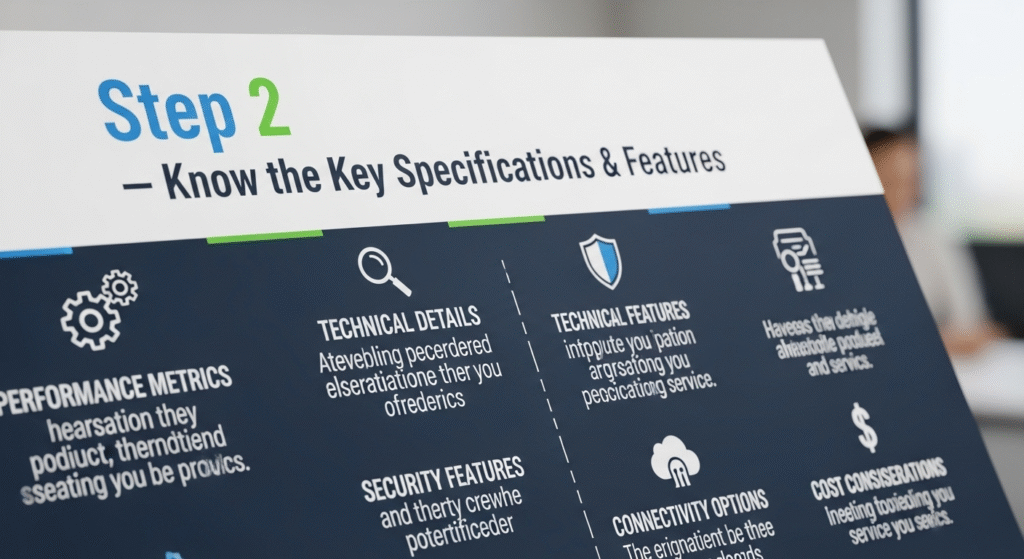
1. Why specifications matter
Specifications (or “specs”) are not just numbers — they describe how a product performs, how long it lasts, and how comfortable it is to use.
Think of specs as the product’s DNA. When you know how to read them, you can predict how it will behave before you even touch it.
For example:
- Power (Watts) tells you how strong or fast a device is.
- Capacity (Liters, GB, or mAh) tells you how much it can handle.
- Material (Plastic, Metal, or Glass) tells you how durable it’ll be.
- Weight tells you whether it’s portable or not.
- Noise level (in decibels) tells you if it’ll drive you crazy at night.
But here’s the key: each spec only matters if it connects to your need.
If you’re buying a small desk fan, high power might just mean it’s louder, not better.
If you’re buying a travel gadget, weight and battery life matter more than speed.
The trick is to read specs in context — not in isolation.
2. Focus on performance, not perfection
When you see product comparisons online, many will claim:
“Ours has 1200W instead of 1000W — more power!”
“Ours has 10% more speed!”
“Ours has double the capacity!”
But here’s the truth: bigger numbers don’t always mean better performance.
Sometimes, more power means more energy use, or more noise.
Sometimes, a large capacity means the product is bulky and hard to store.
And sometimes, that “extra feature” is something you’ll never even use.
Example:
If you’re buying a coffee maker for one person, you don’t need a 12-cup machine.
If you just want a vacuum for light cleaning, you don’t need 2000W of suction — 800W might already be enough.
Instead of chasing perfection, focus on what’s enough for your use.
The goal isn’t to buy the “most powerful” product — it’s to buy the right-sized solution for your life.
3. Learn what each common spec actually means
Let’s make this simple.
Here are some everyday examples across product types:
| Category | Common Spec | What It Means | What to Look For |
|---|---|---|---|
| Electronics | Power (Watts) | Speed and strength of operation | Balance between power and noise/heat |
| Home Appliances | Capacity (Liters / kg) | How much it can hold | Enough for your family size, not excess |
| Batteries & Gadgets | Battery (mAh) | How long it runs per charge | 20–30% higher than advertised minimum |
| Computers / Phones | Memory (GB / RAM) | Ability to multitask smoothly | Minimum 8GB RAM for regular use |
| Speakers / Headphones | Frequency Range (Hz–kHz) | Audio clarity and depth | Human hearing: 20Hz–20kHz |
| Lighting | Brightness (Lumens) | How bright it appears | 400–800 lumens for indoor use |
| Noise Level | dB (Decibels) | Sound level – comfort measure | Below 60dB = quiet device |
| Materials | Plastic / Metal / Stainless Steel | Determines durability & feel | Prefer stainless steel or BPA-free plastic |
| Warranty | 6–24 months | Brand confidence & protection | At least 12 months preferred |
👉 These aren’t just “facts.” Each number tells you how the product will behave in your real life.
4. Understand the trade-offs
Every feature comes with a cost — sometimes in money, sometimes in comfort, sometimes in durability.
The best buyers understand that there’s no perfect product, only trade-offs.
For example:
- Higher power = faster results, but more noise and energy use.
- Bigger battery = longer life, but heavier and slower to charge.
- More functions = flexibility, but steeper learning curve.
- Lighter weight = portable, but maybe less sturdy.
The trick is to find your sweet spot — the balance between performance, comfort, and budget.
Ask yourself:
“Which trade-off am I okay with, and which one would frustrate me every day?”
If you can answer that honestly, you’ll make the right choice — every time.
5. Don’t get fooled by “extra features”
You’ll often see products with big lists of features — some of which sound incredible but don’t actually add value.
For example:
- “Smart mode,” “Turbo mode,” or “AI mode” — sometimes just a marketing name for normal settings.
- “Special coating” or “Nano technology” — sounds high-tech, but rarely affects real use.
- “3-in-1” or “5-in-1” products — often do everything okay, but nothing well.
Rule of thumb:
If a feature doesn’t clearly make your experience safer, faster, or easier — it’s probably unnecessary.
Pay for function, not for labels.
6. Check for future-proofing
Technology changes fast. A product that’s great today might feel outdated next year.
While you can’t predict the future, you can choose wisely by looking for:
- Standard connections: (USB-C, Bluetooth 5.0, Wi-Fi 6, etc.)
- Replaceable parts: Batteries, filters, cables.
- Software support: Updates or app compatibility if it’s a smart device.
- Universal fit: Accessories that can be found easily online.
Buying something slightly more modern or modular can extend its lifespan and save you from replacing it too soon.
7. Compare specs visually
Sometimes reading specs can feel like reading a foreign language.
That’s why side-by-side comparison tables help so much.
Example layout:
| Feature | Model A | Model B | Model C |
|---|---|---|---|
| Power | 800W | 1000W | 1200W |
| Capacity | 1.5L | 2.0L | 2.5L |
| Noise Level | 65dB | 60dB | 55dB |
| Warranty | 12 months | 18 months | 24 months |
| Best For | Solo user | Small family | Heavy use |
With one glance, you can see patterns.
Then, you can ask yourself, “Do I really need to jump from 800W to 1200W for double the price?”
Often, the answer is no.
8. Understand the “hidden specs”
Some qualities never appear in product descriptions but make a huge difference:
- Ease of cleaning: Can you reach small corners easily?
- Ergonomics: Are the buttons comfortable to use?
- Build feel: Does it feel solid or hollow in your hand?
- Real energy efficiency: How much electricity or battery it uses per hour.
- Customer service quality: Fast replies, easy warranty claims.
These aren’t listed as specs — but they affect your daily experience far more than any number on the box.
9. Learn to read between the lines
When a product description says things like:
- “Up to 10 hours battery life” → It’s usually less under real use.
- “Premium materials” → Ask: which material exactly?
- “Whisper-quiet” → Check the decibel rating.
- “Limited-time offer” → Check if it’s actually permanent (many are).
Be a little skeptical — not cynical, just aware.
Marketing loves exaggeration; real buyers love precision.
10. Don’t overthink — learn just enough
You don’t have to become an engineer to understand product specs.
All you need is basic literacy in what matters for your use.
Once you learn to read specs the smart way, you’ll stop being overwhelmed — and start being in control.
Remember:
You’re not buying numbers.
You’re buying comfort, durability, and satisfaction.
Final thought
Specifications are like a language.
Once you learn to speak it — even just a little — no seller or ad can confuse you again.
You’ll be the kind of buyer who asks the right questions, compares logically, and walks away with exactly what you need.
Step 3 – Compare Product Types & Categories
One of the most confusing parts of buying anything today is deciding which version or category actually fits you.
There’s never just “one” product anymore — there are ten versions, each with slightly different labels, features, and prices.
You’ll see words like “Pro,” “Lite,” “Max,” “Deluxe,” or “Smart” — and it’s easy to wonder:
“Do I really need the advanced one, or is the basic model enough?”
Let’s break that confusion down step by step.
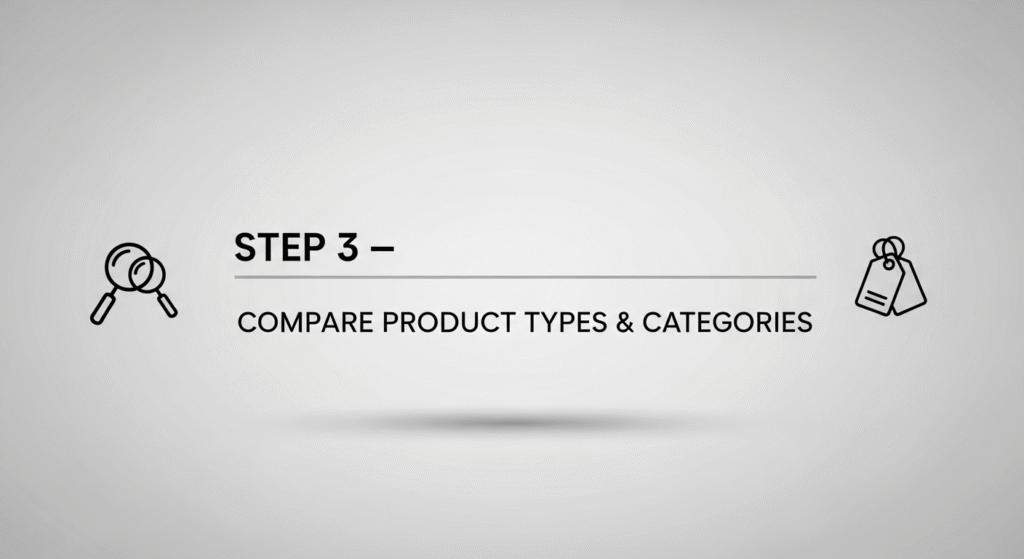
1. Understand what “types” really mean
Every product category has 2–3 main types or levels, usually based on performance, automation, or build quality.
For example:
| Category | Basic Type | Mid-Range Type | Premium Type |
|---|---|---|---|
| Coffee Makers | Manual press | Semi-automatic | Fully automatic / Smart |
| Headphones | Wired | Bluetooth | Noise-cancelling |
| Cameras | Compact | Mirrorless | DSLR |
| Vacuum Cleaners | Corded | Cordless | Robot vacuum |
| Air Purifiers | Basic filter | HEPA filter | Smart sensor + app control |
Each “upgrade” adds more comfort or convenience — but also a higher price.
The key is to match the type with your usage frequency and expectations, not with marketing promises.
2. Don’t assume “premium” means “better”
Marketers love to make us think that more expensive automatically means better.
But in reality, premium products are only better if you’ll actually use what they offer.
For example:
- A robot vacuum is amazing — but if your home has uneven floors or carpets, a cordless stick vacuum might still be more practical.
- A noise-cancelling headphone is great — but if you only listen to podcasts at home, you don’t need to pay for that feature.
- A “smart” air purifier with Wi-Fi and app control sounds cool — but if you’ll just press the button once a day, a mid-range HEPA filter will do the same job for half the price.
In other words:
Pay for functionality you’ll use, not for features that sound impressive.
3. Match the product type to your lifestyle
Here’s a simple way to decide which category fits you best:
| User Type | Ideal Product Type | Why It Fits |
|---|---|---|
| Occasional user | Basic | Easy to use, low cost, less maintenance |
| Regular user | Mid-range | Balanced performance and price |
| Power user / Professional | Premium | Long lifespan, more control, reliability |
👉 Rule of thumb:
If you’ll use it once a week — go basic.
If you’ll use it daily — go mid-range.
If you’ll rely on it for work or long-term results — go premium.
4. Don’t let FOMO drive your decision
You don’t need to own the newest or most high-tech version of everything.
What you need is the version that makes your life easier without adding complexity or cost.
Ask yourself:
- “Will I use this extra feature regularly?”
- “Does it really save me time or effort?”
- “Would a simpler version do 90% of the job?”
Smart buyers know that the best purchase isn’t the most advanced — it’s the most appropriate.
5. Final thought
Comparing product types isn’t about choosing the “best” — it’s about finding what’s best for you.
Once you understand the category structure and know which features matter, you can confidently pick the right model for your lifestyle and budget.
Step 4 – Evaluate Build Quality & Materials
When you buy something new, the first thing that decides how long it lasts isn’t the brand — it’s how well it’s built.
The materials, the design, the small details in construction — they all determine whether your product feels solid or cheap, reliable or disposable.
Sadly, build quality is also the hardest thing to judge from a screen.
Photos can look flawless, descriptions can sound convincing — but reality can be very different.
That’s why this step will show you how to evaluate quality even when shopping online.
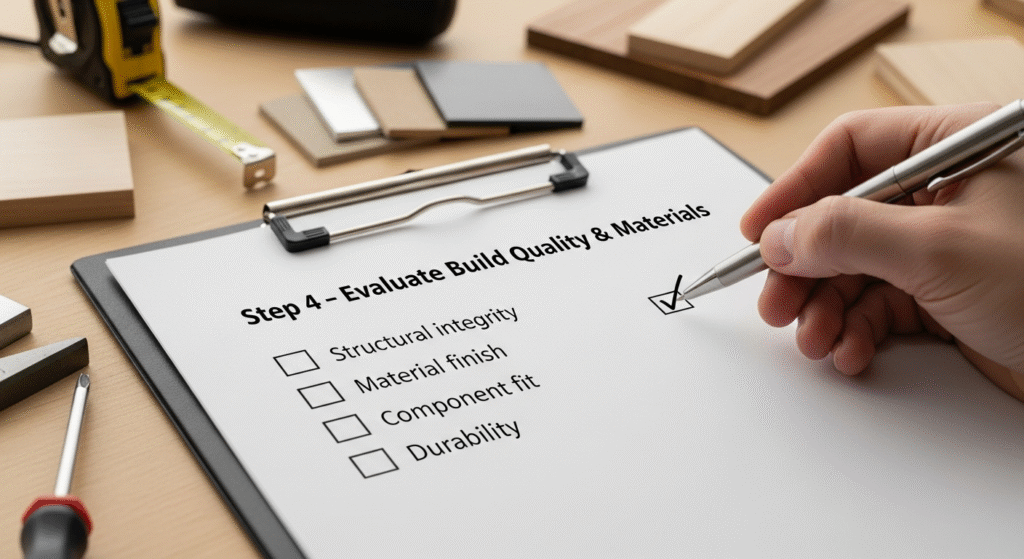
1. Why build quality matters
A product with good build quality:
- Lasts longer
- Works more smoothly
- Feels better to use
- Looks better over time
Meanwhile, poor materials can cause hidden problems:
- Plastic parts cracking after a few months
- Buttons that fade or get stuck
- Metal that rusts or paint that chips
- Screws that loosen or creak noises after short use
So, how do you tell which is which — without physically touching it?
Let’s start with the most obvious clue: materials.
2. Understand common material types
Each material has its strengths and weaknesses. Knowing them helps you predict how a product will age, perform, and feel.
| Material Type | Pros | Cons | Best Used For |
|---|---|---|---|
| Stainless Steel | Durable, rust-resistant, elegant look | Heavier, can be expensive | Appliances, cookware, long-term tools |
| Aluminum | Lightweight, resists corrosion, good heat transfer | Can dent easily, less strong than steel | Laptops, travel gear, kitchen items |
| ABS Plastic | Affordable, impact-resistant, lightweight | May yellow or crack over time | Household items, electronics housing |
| Glass | Non-toxic, stylish, easy to clean | Fragile if dropped, heavier | Kitchen containers, bottles, decor |
| Wood / Bamboo | Natural, aesthetic, eco-friendly | Needs care, can warp with moisture | Furniture, utensils, home decor |
3. How to spot good build quality online
Even if you can’t hold the product in your hands, you can still spot clues:
🟢 Check close-up images
Zoom in on:
- Buttons, seams, and edges
- Joints and hinges
- Corners, screws, or stitching lines
If photos show clean joins and tight assembly, that’s a good sign.
If you see gaps, rough finishes, or uneven paint — quality control may be poor.
🟢 Read user reviews with images
Skip the generic “Good product!” comments.
Focus on buyers who post photos after using it for a while — look for mentions of:
- Weight and sturdiness
- Finishing quality
- Whether it feels “cheap” or “solid”
Real users often describe texture, smoothness, or durability better than specs ever could.
🟢 Search for keywords like “solid,” “heavy,” or “premium feel”
When these appear repeatedly, it’s a strong quality indicator.
If you see too many mentions of “lightweight plastic” or “flimsy,” that’s a red flag.
4. Watch for design and finishing details
A product’s design reveals how much thought the manufacturer put into user experience.
Good design signs:
- Rounded edges instead of sharp corners
- Buttons with clear click feedback
- Smooth joints without squeaking
- No excessive gaps between parts
Bad design signs:
- Shiny but thin plastic
- Misaligned components
- Loose or sticky mechanisms
- Rough paint or uneven coating
Even small design flaws can signal poor production consistency.
5. Pay attention to warranty and materials description
A confident brand proudly mentions specific materials (e.g., “304 stainless steel” or “solid oak”), while low-quality sellers often say vague things like “premium material” or “durable design.”
And here’s a rule that rarely fails:
If a product comes with a long warranty, it’s usually well built.
No company offers 2 years of warranty on something that easily breaks.
6. Look for certifications and safety standards
Certifications are often overlooked but say a lot about build quality.
Depending on what you buy, look for:
- CE / RoHS / FCC → Electronics and appliances
- FDA / BPA-Free → Food containers and kitchenware
- ISO / ASTM / SGS Tested → Industrial and safety standards
These symbols mean the product was actually tested — not just advertised.
7. Feel (or imagine) the texture
If you’ve ever held a cheap gadget, you know the difference instantly — it’s in the feel.
Even when shopping online, try to visualize texture from photos and user descriptions:
- Matte = premium, non-slip
- Glossy = often cheaper plastic
- Metal finish = heavier, long-lasting
- Rubber grip = safer and more ergonomic
This small detail can turn a basic purchase into something you actually enjoy using.
8. Final thought
In the end, build quality isn’t about perfection — it’s about confidence.
When a product feels sturdy, works smoothly, and looks consistent across every detail, you know you’re buying something that will stay with you for years, not months.
So next time you shop, don’t just ask,
“What does it do?”
Ask also,
“What is it made of, and how well is it made?”
That simple shift will save you countless disappointments — and money.
Step 5 – Understand Brand Reputation & Warranty
In today’s world, anyone can sell anything online.
You’ll see thousands of “brands” on shopping sites — but how many of them actually exist beyond the internet?
Choosing the right product isn’t just about specs or materials.
It’s about trust.
A good brand stands behind its product; a bad one disappears the moment you have a problem.
Let’s see how to tell them apart.
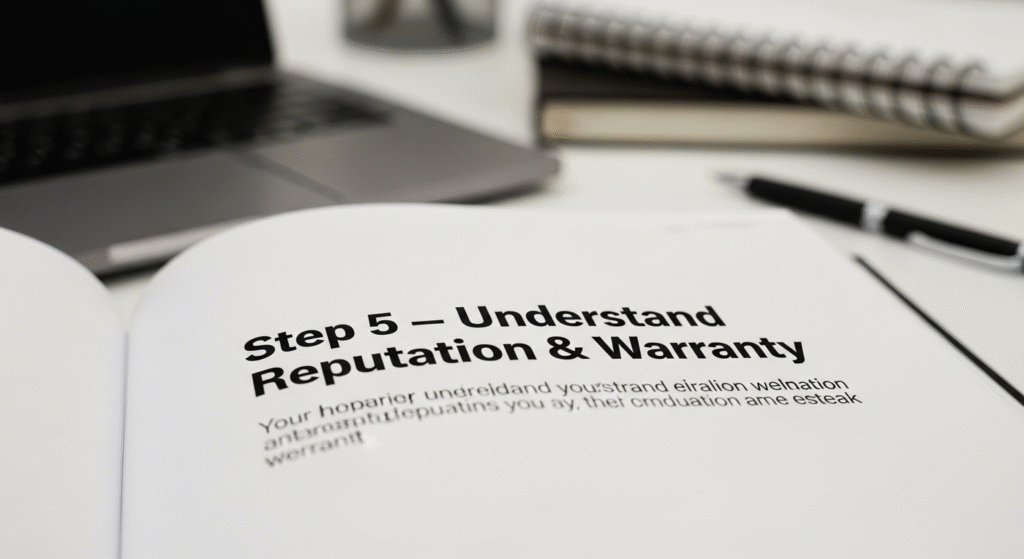
1. Why brand reputation matters
Think of a brand as a promise.
When you buy from a reputable company, you’re not just paying for the product — you’re paying for:
- Quality control (fewer defects)
- Transparency (real materials, clear descriptions)
- Customer support (help when something goes wrong)
- Warranty you can actually use
Unknown or “ghost” brands often skip all that.
They copy designs, cut corners, and disappear after the sale.
So, while the upfront cost looks cheaper, you’re actually paying more — in frustration, time, and replacements later.
2. How to research a brand before buying
You don’t need to be a detective — just follow a few smart checks.
🟢 Check their online presence
Look for an official website, not just a store page.
A real brand usually has:
- A professional website (with “About,” “Contact,” and “Support” pages)
- Clear company information
- Multiple products within one niche (not random items from different categories)
🟢 Search for reviews outside the store
Type the brand name on Google + “review,” “complaint,” or “scam.”
If all you see are marketplace listings and no independent mentions — that’s suspicious.
🟢 Look at the product range
Good brands stay consistent.
If a seller is selling both headphones and frying pans under the same name — it’s a red flag.
🟢 Evaluate packaging and presentation
Small detail, big signal.
If product photos show neat packaging, consistent logos, and care instructions — that brand takes itself seriously.
3. Understand warranty: what it actually means
A warranty isn’t just a number — it’s a reflection of how much the company believes in its product.
- Short warranty (3–6 months) → often signals disposable or low-cost items
- Standard warranty (12 months) → average reliability
- Extended warranty (2–3 years) → brand confidence
- Lifetime warranty → extremely rare, but great if legitimate
But always read the fine print.
Ask yourself:
- Does the warranty cover parts and labor, or just one of them?
- Do you have to pay for shipping or replacement fees?
- Is there an official service center, or only email support?
If it’s difficult to contact the seller or unclear how returns work — that’s not a real warranty.
4. Typical warranty periods by product type
| Product Type | Average Warranty | Good Brand Standard | What It Says About Quality |
|---|---|---|---|
| Electronics (phones, laptops) | 12 months | 18–24 months | Brands confident in durability and components |
| Small Appliances (blenders, vacuums) | 6–12 months | 12–24 months | Good internal motors, tested build quality |
| Power Tools | 12 months | 2–3 years | Heavy-duty reliability for frequent use |
| Home & Kitchen Accessories | 3–6 months | 12 months | Brand ensures long-term customer satisfaction |
| Wearables & Smart Devices | 6–12 months | 12–18 months | Stable performance, verified testing |
5. Red flags in warranty and brand promises
Be cautious if you notice:
- Vague terms like “premium warranty” without details
- Only email support with no phone or address listed
- Seller says “contact manufacturer,” but manufacturer says “contact seller”
- Warranty starts from shipping date instead of purchase date
Good brands are clear, simple, and consistent.
If it’s hard to understand, that’s usually intentional — they don’t want to be responsible.
6. Check for authorized sellers
Even the best brand can disappoint if you buy from an unauthorized source.
Always look for:
- “Ships from and sold by [Brand]” (on Amazon or eBay)
- Authorized dealer lists on the brand’s official website
- Avoid listings with suspiciously low prices or unfamiliar store names
Authorized sellers guarantee you get:
- Genuine products
- Valid warranties
- Customer service that actually responds
7. How to recognize fake “brands” online
Here’s a quick test:
If the brand name sounds random — like “TechGuruX” or “HomeJoyPro” — and you can’t find a real company behind it, it’s probably just a label, not a real brand.
Signs of fake brands:
- Many unrelated products
- Stock photos with different logos
- Generic product names
- Reused descriptions copied from big brands
If it feels “too generic to be real,” it usually is.
8. Final thought
Brand reputation isn’t about being famous — it’s about being accountable.
A good brand shows up when something goes wrong.
They don’t just sell you a product; they stay with you through its entire lifespan.
When you choose a brand that stands for something, you’re not just buying an item — you’re buying peace of mind.
And that, in the long run, is worth far more than a small discount.
Step 6 – Learn How to Read Real Customer Reviews
We’ve all done it — scrolling through hundreds of reviews, trying to figure out if a product is actually worth it.
But the truth is, not all reviews are created equal.
Some are honest and helpful, others are fake, paid, or written in a rush.
So, how do you tell the difference?
How do you make sure you’re trusting real experiences — not marketing manipulation?
Let’s break it down.

1. Don’t trust the average star rating alone
A 4.8★ product isn’t always better than a 4.3★ one.
Why? Because numbers don’t tell stories — people do.
Some sellers flood their listings with short, generic 5-star reviews to boost rankings.
Instead of focusing on the overall score, look for:
- How recent the reviews are
- How detailed the experiences sound
- How consistent the comments are about pros and cons
If a product has 2,000 perfect 5-star ratings but all reviews sound like “Great product, fast shipping!” — be careful.
A smaller product with 200 honest, detailed reviews might be a far safer choice.
2. Identify real vs. fake reviews
Fake reviews are everywhere — especially on big marketplaces.
Luckily, once you know the signs, they’re easy to spot.
| Indicator | Real Review | Fake Review |
|---|---|---|
| Language | Natural, includes emotion and real usage details | Generic, repetitive, full of marketing phrases |
| Length | Medium to long (3–5 sentences) | Very short (1 line like “Great product!”) |
| Tone | Balanced: mentions both pros and cons | Overly positive or perfect with no flaws |
| Timing | Posted over different dates | Many reviews appear within a few days |
| Photos | Shows real-life use or packaging | No photo or uses stock image |
| Reviewer Profile | Has other reviews, verified purchase tag | Empty profile, no buying history |
3. Look for patterns — not perfection
A great review section doesn’t mean everyone loves the product.
In fact, the most trustworthy listings often have a mix of 3★, 4★, and 5★ reviews.
When 10–20% of buyers mention the same minor issue, that’s normal.
When dozens complain about the same serious flaw, that’s a red flag.
✅ Example of healthy consistency:
“Works great but a bit loud” — repeated several times → means that’s a known trade-off.
❌ Example of suspicious consistency:
“Amazing! Best product ever! Will buy again!” — repeated word-for-word → likely fake.
4. Read the “middle” reviews first
Most buyers only read 5★ and 1★ reviews — the two extremes.
But the most honest and helpful feedback lives in the middle — the 3★ or 4★ range.
These reviewers often:
- Tell what they liked and what could be improved
- Post after days or weeks of use
- Sound like real people, not promoters or haters
If you only have time for a few reviews — read these first.
5. Use tools that detect fake reviews
There are some excellent free tools that analyze authenticity patterns:
- 🧠 Fakespot.com – Grades products (A–F) based on review reliability.
- 🔎 ReviewMeta.com – Recalculates average rating after filtering fake reviews.
- 🛠️ Keepa / CamelCamelCamel – Shows if a sudden review spike matches price drops (common manipulation tactic).
If a product has “too perfect” ratings but low trust scores on these tools — skip it.
6. Focus on long-term feedback
When possible, look for reviews from people who’ve used the item for months.
Phrases like:
- “After 6 months of use…”
- “I’ve bought this twice already…”
- “Still working great after a year.”
…are gold.
They tell you how the product ages, not just how it feels on day one.
7. Don’t be tricked by photo-only reviews
Sometimes sellers pay users to upload a photo and leave a star without text.
Photos help, but without real words describing the experience, they’re meaningless.
A true review usually explains how the photo connects to usage — for example:
“This is after 3 months of use — still no rust.”
That’s authentic.
A random image with “Good!” isn’t.
8. Pay attention to language and emotion
Genuine reviews sound personal and specific.
They mention:
- How the product fits into daily life
- How it solved a problem
- How they felt using it
Fake ones sound robotic or exaggerated, full of words like:
“Amazing product! Super high quality! Fast shipping!”
Those are red flags.
9. Look for “verified purchase” labels
Platforms like Amazon and Shopee mark real buyers with a tag such as “Verified Purchase.”
If a review lacks that tag, treat it with caution — especially if it’s overly positive or posted in bulk.
10. Final thought
Learning to read reviews is like learning to read between the lines.
Once you know the patterns — tone, timing, language, and details — you’ll never fall for fake hype again.
Because the smartest buyers don’t just look for good reviews —
they look for true reviews.
Step 7 – Price, Value & Timing the Purchase
Everyone wants a good deal — that feeling of getting more than what you paid for.
But here’s the truth: a low price doesn’t always mean a good deal, and a high price doesn’t always mean a rip-off.
The smartest buyers focus on value, not just price tags.
1. Price is what you pay — value is what you get
A product can be cheap but cost you more in the long run if it breaks early, performs poorly, or needs constant replacement.
On the other hand, a slightly more expensive item can save you time, frustration, and even money over its lifespan.
Think of it like this:
Price = one-time expense.
Value = lifetime satisfaction.
The real goal is to find that sweet spot where price and quality meet — where the product feels worth it every time you use it.
2. Understand price tiers
Every product category naturally falls into three price levels: Budget, Mid-range, and Premium.
Let’s break down what each tier usually means.
| Tier | Average Price Range | What You Get | Best For |
|---|---|---|---|
| Budget | Lowest 20% of the market | Basic function, limited features, shorter lifespan | Occasional users, temporary use |
| Mid-range | Average to slightly above average | Balanced quality and performance | Everyday use, best long-term value |
| Premium | Top 20% price range | Top build quality, design, warranty, and features | Frequent users, professionals, or gifts |
3. Calculate “value per use”
Here’s a mindset shift that changes everything:
Instead of asking, “How much does it cost?”, ask,
“How much value do I get every time I use it?”
If a $200 product lasts five years and you use it daily, that’s about 10 cents per day — incredible value.
If a $50 product breaks in six months, that’s 28 cents per day — more expensive than it looks.
📏 Formula:
Value per use = Total cost ÷ Number of uses
This mindset instantly changes how you view expensive vs. cheap products.
4. Know when to buy (timing is everything)
Even the best buyers can save 10–40% just by knowing when to buy.
Most online retailers follow predictable discount cycles throughout the year.
Here’s when to look for real deals:
| Time of Year | Best For | Typical Discount |
|---|---|---|
| January – February | Home goods, fitness, and storage items | 15–30% |
| March – May | Electronics and outdoor tools | 10–25% |
| July (Mid-year sales) | Tech, small appliances | 20–35% |
| November (Black Friday / Cyber Monday) | Almost everything | 30–70% |
| December (Post-holiday clearance) | Fashion, decor, and gifts | 20–50% |
📅 Pro tip: Track prices using tools like CamelCamelCamel or Keepa on Amazon.
They show a full price history — so you’ll know if a “discount” is real or fake.
5. Beware of psychological pricing traps
Marketers are clever — they know how to make you feel like you’re saving money.
Here are some common traps:
| Marketing Trick | What It Really Means |
|---|---|
| “Limited time offer” | The sale will repeat next week |
| “Buy one get one free” | The first item’s price is inflated |
| “Was $199, now $99” | The “was” price might never have existed |
| “Flash sale ends in 1 hour” | Artificial urgency to make you rush |
The antidote is simple:
Never buy out of emotion. Always check past prices or wait 24 hours before finalizing.
6. Watch out for “false value”
False value happens when you get a discount on something you didn’t need in the first place.
If you wouldn’t buy it at full price, it’s not a deal — it’s a distraction.
A true value purchase means:
- You planned it.
- You researched it.
- You’ll actually use it.
Anything else is just marketing psychology at work.
7. Consider total cost of ownership (TCO)
The real price of a product includes more than its sticker price:
- Maintenance (filters, batteries, refills)
- Accessories (cases, chargers, replacement parts)
- Energy consumption (electricity, fuel, etc.)
- Shipping or return costs
A cheaper product with high maintenance costs can easily surpass a premium one after a year.
So, always ask:
“How much will it cost me to own this — not just buy it?”
8. When in doubt — wait
Patience is one of a smart shopper’s greatest weapons.
Prices fluctuate constantly. If you’re not in a rush, add the item to your cart and monitor it for a week.
Retailers often send personalized discount codes when they notice you hesitating — yes, really!
9. Final thought
Price gives you information.
But value gives you peace of mind.
If you buy cheap, you’ll celebrate once — at checkout.
If you buy quality, you’ll celebrate every time you use it.
The best time to buy is when you understand the product, the price, and your purpose.
That’s the point where smart buying begins.
Step 8 – Buying Safely Online
Shopping online is easy — sometimes too easy.
With one click, you can buy anything from anywhere in the world.
But that same convenience also opens doors for scams, fake sellers, and unsafe websites.
The good news?
If you follow a few simple rules, you can shop confidently and safely — every time.
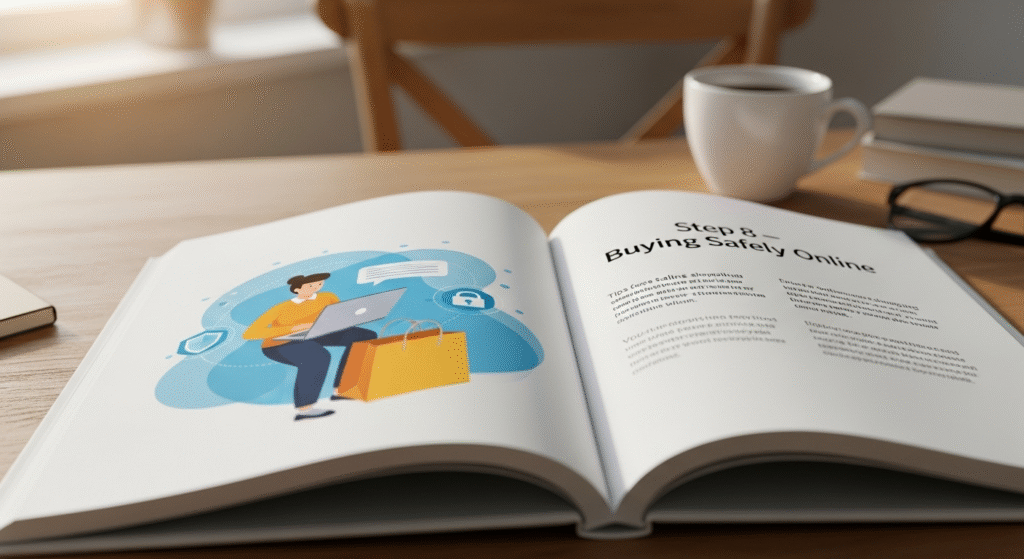
1. Always buy from trusted platforms
Stick to well-known marketplaces like Amazon, Walmart, Best Buy, or major retailers in your region.
These platforms have:
- Buyer protection policies
- Verified seller programs
- Refund and return systems
If you’re buying from smaller websites, check:
- Do they use HTTPS (the lock icon)?
- Do they have clear contact info and return policy?
- Is the payment page secure and familiar (PayPal, Stripe, etc.)?
If the website looks suspiciously simple or has poor grammar everywhere — don’t risk it.
2. Check seller credibility
Even on big platforms, not every seller is trustworthy.
Before clicking Buy Now, check:
- Ratings and feedback (aim for 95%+ positive)
- Years active on the platform
- “Ships from and sold by” – avoid unverified third parties
- Reply quality to buyer questions — scammers rarely reply clearly
If the seller doesn’t exist outside that one listing, or their brand name is nonsense — step away.
3. Compare price realism
If a deal looks too good to be true, it probably is.
Scammers use unrealistically low prices to lure you into fake checkout pages or collect card info.
✅ Smart rule: If the price is 40% lower than everywhere else, verify the seller twice.
Use Google Shopping or PriceRunner to see if similar items exist at that rate.
4. Use secure payment methods
Always pay through trusted gateways — never by direct bank transfer or sending money to random accounts.
Safe options:
- Credit card (offers dispute protection)
- PayPal (refund guarantee)
- Apple Pay / Google Pay (adds encryption layer)
Risky options:
- Bank wire
- Western Union
- Crypto payments (irreversible)
- Cash on delivery for high-value electronics
If the seller insists on direct payment, it’s a red flag 🚩.
5. Check website security before entering details
Look at the URL before typing your card number:
- ✅ Starts with https://
- ✅ Has a small lock icon
- ❌ Avoid if it shows “Not Secure”
If the checkout page suddenly redirects to another unfamiliar site — cancel immediately.
And never shop while connected to public Wi-Fi.
Use your mobile data or a trusted home network.
6. Recognize fake websites and phishing scams
Scammers often create copycat sites that look almost identical to real ones.
They change one letter in the domain (like “amaz0n” or “dysonn”) or clone the design.
Signs of a fake site:
- URLs with numbers or strange endings (e.g., “shop-best123.com”)
- Too many pop-ups or forced login requests
- Unrealistic discounts (“90% OFF EVERYTHING”)
- “Testimonials” with stock photos or broken English
If something feels off, it probably is.
7. Protect your personal information
Only share what’s necessary — your name, shipping address, and payment info.
Never give away:
- Full ID or passport
- Bank login details
- OTP verification codes
- Card photos
Scammers often pretend to be “customer support” asking for verification — no real company does that.
8. Read return & refund policies carefully
Before buying, check:
- How many days you have to return
- Who pays for return shipping
- If refunds are processed to your card or as store credit
Good sellers clearly explain these terms.
If policies are missing, vague, or hidden deep inside the website — don’t buy.
9. Use buyer protection and dispute systems
If something goes wrong:
- Contact the seller first (always through the platform)
- Keep screenshots, invoices, and messages
- If ignored, open a dispute with the payment provider
Platforms like PayPal and Amazon almost always side with the buyer if you have clear evidence.
10. Recognize safe vs risky buying behavior
| Behavior | Safe Buyer | Risky Buyer |
|---|---|---|
| Website Check | Buys from HTTPS, verified stores | Buys from random sites with “big sale” banners |
| Payment Method | Uses credit card or PayPal | Sends bank transfers or crypto payments |
| Price Awareness | Compares prices across platforms | Buys instantly because “too cheap” |
| Personal Data | Shares only required info | Uploads ID or sends OTP to “support” |
| Return Policy | Reads terms before paying | Finds out too late after delivery |
11. Keep proof of purchase
Always save:
- Order confirmation emails
- Receipts or transaction IDs
- Shipping tracking numbers
These are your legal proof if disputes or refunds are needed.
Take a screenshot before and after checkout, just in case.12. Update and protect your devices
Cyber safety starts with your tech:
- Keep your browser and antivirus updated
- Use strong, unique passwords
- Enable 2-step verification for your main accounts
These simple steps stop 90% of online fraud attempts.
13. Final thought
Online shopping doesn’t have to be risky — it just has to be smart.
By combining awareness, research, and secure habits, you’ll never fall for fake stores or shady deals again.
Remember:
It’s not about being afraid to buy online —
It’s about being too smart to be fooled.
Step 9 – Post-Purchase: Maintenance, Returns & Smart Re-Buying
The buying process doesn’t end when you click “Buy Now.”
In fact, that’s just the beginning.
How you unbox, check, use, maintain, and manage your product after purchase determines whether it becomes a smart investment — or a short-term regret.
This step will show you how to take full control after the purchase — and make every item you buy work harder and last longer for you.
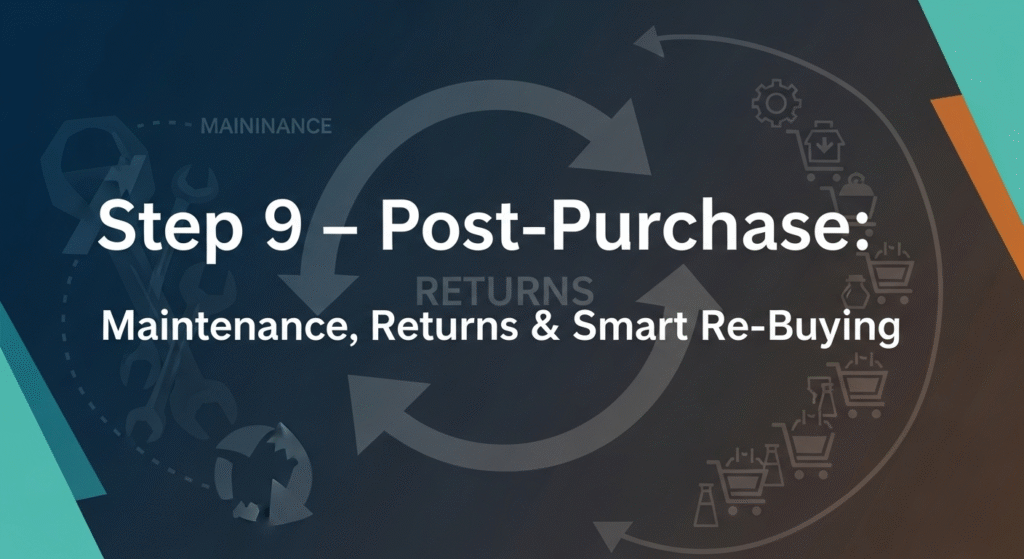
1. Inspect your order immediately
When your package arrives, don’t rush to throw away the box.
Start by verifying three things:
✅ Correct item – Check model, size, and color against your order confirmation.
✅ Condition – Look for dents, scratches, missing parts, or seals that appear opened.
✅ Completeness – Ensure all accessories, manuals, and cables are included.
If anything seems off — take photos before using the product.
These will be essential if you need a replacement or refund.
2. Test the product right away
Most stores only allow 7–14 days for returns.
Use that window wisely:
- Plug it in, charge it, or test every feature.
- Check for any defects or “dead on arrival” issues.
- Try it under normal use conditions, not just unboxing.
Waiting too long may forfeit your right to a refund or replacement.
3. Register the warranty
Brands often offer online warranty registration — don’t skip it.
It ensures faster support if you ever need repairs and sometimes extends your coverage.
Keep your invoice or receipt PDF stored safely in both digital and printed form.
4. Learn the maintenance basics
Every product has its rhythm.
Simple maintenance can double its lifespan.
| Product Type | Maintenance Tip |
|---|---|
| Electronics | Keep away from moisture; clean ports and fans every few months |
| Appliances | Descale, replace filters, and unplug when not in use |
| Clothing / Fabric | Follow wash labels; air-dry instead of tumble-dry |
| Tools | Oil or clean metal parts to prevent rust |
| Furniture | Avoid direct sunlight; use mild cleaners only |
A few minutes of care saves you hundreds of dollars in replacements.
5. Store and handle packaging wisely
Keep your original packaging for at least 2–3 weeks.
Why? Because:
- It helps with safe returns or exchanges.
- Some brands require the original box for warranty claims.
- It makes resale easier if you upgrade later.
Store manuals and small parts (like screws or adapters) together in a labeled zip bag.
6. Know the return process before you need it
If something goes wrong:
- Contact the seller through the platform’s message center — not email.
- Explain clearly with photos or short videos of the issue.
- Stay polite but firm; clarity gets faster responses.
- Track the return with the shipping label and note the refund timeline.
Most reputable sellers handle returns smoothly if you document everything.
7. Keep track of product lifespan
A smart buyer doesn’t just buy — they track.
Create a simple spreadsheet or phone note to record:
- Purchase date
- Warranty end date
- Replacement cycles (e.g., filters, blades, batteries)
That way, you’ll know exactly when to repair, replace, or upgrade.
8. Learn from each purchase
After a few weeks, ask yourself:
- Did this product actually solve my problem?
- Would I buy it again?
- What would I do differently next time?
This reflection builds your personal buying intuition — something no review or ad can teach.
9. Re-buy smarter next time
If you loved a product, note:
- The brand’s reliability
- The model name
- The purchase season or discount time
When it’s time to re-buy or upgrade, you’ll save hours of research — and avoid repeating mistakes.
10. Post-Purchase Checklist
| Task | When to Do It | Why It Matters |
|---|---|---|
| Inspect package and product | Immediately after delivery | Ensures no damage or missing parts |
| Test all functions | Within first 3–5 days | Allows quick return if defective |
| Register warranty | Within first week | Secures long-term protection |
| Keep invoice and box | At least 30 days | Required for refunds or exchanges |
| Start maintenance routine | After 1 week of use | Improves durability and performance |
| Review your experience | After 1 month | Helps others and refines your buying skill |
11. Don’t forget to leave your review
Your experience helps future buyers.
Write clear, honest feedback after at least a week of use — not just right after unboxing.
Mention:
- Pros and cons
- Any hidden details or surprises
- Whether you’d recommend it
Good reviews don’t just help others — they build community trust.
12. Final thought
Buying smart doesn’t stop at checkout — it continues through how you use, care for, and think about your purchases.
Every product can teach you something — about quality, patience, and awareness.
So, treat each purchase as a small experiment in mindful consumption.
You’ll not only save money — you’ll also buy less, but better.
Step 10 – Final Buying Mindset: From Impulse to Intention
We live in a world that makes it easy to buy, but hard to think.
Every scroll, every ad, every “limited offer” is designed to trigger a reaction — not a reflection.
It whispers: “You need this.”
But most of the time, you don’t.
The final step of smart shopping isn’t about deals, brands, or discounts.
It’s about awareness — understanding why you buy, not just what you buy.
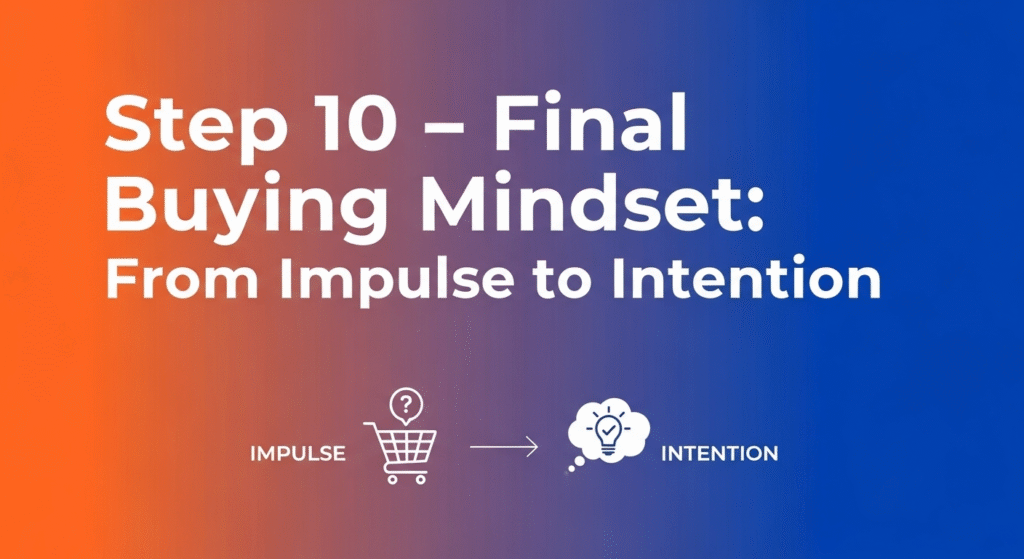
1. The truth about impulse buying
Impulse buying isn’t just about lack of discipline — it’s about emotion.
You buy when you’re bored, stressed, or looking for a quick hit of satisfaction.
The product isn’t what you want — it’s the feeling it promises.
But that feeling fades quickly.
And when it does, you’re left with clutter, regret, and a smaller wallet.
So the goal isn’t to stop buying.
It’s to start buying with intention.
2. How to turn impulse into awareness
Before you click Buy, pause for just 10 seconds and ask:
- Do I really need this?
Or am I just reacting to an emotion or ad? - Will I still want this in 7 days?
If not, it’s just temporary desire. - Does this align with my goals or values?
Will it make my life easier, better, or more meaningful? - What will I trade for it?
Not just money — but time, space, or focus.
If the answer to any of these questions feels uncertain — wait.
You’ll be surprised how often the urge disappears when you give it time.
3. Redefine what “worth it” means
Most people define “worth it” as “cheap for what it gives.”
But that’s shallow.
Real value isn’t in price — it’s in purpose.
A product is truly worth it when:
- It solves a real problem in your life.
- It replaces something wasteful.
- It improves your daily routine.
- You use it often and it brings peace, not guilt.
Owning fewer, better things gives you freedom — not limitation.
It’s the opposite of scarcity: it’s intentional abundance.
4. The mindful buyer’s loop
Here’s a simple mindset loop to remember — every time you shop:
5. Build a personal “buying philosophy”
Over time, you’ll start noticing patterns in your buying behavior — and that’s powerful.
Create your own set of rules to guide future purchases.
For example:
- “If it’s not a hell yes, it’s a no.”
- “I only buy what I’d proudly recommend to a friend.”
- “I wait 72 hours before any non-essential purchase.”
- “I invest in things that save time, not just money.”
This becomes your shopping compass — it keeps you grounded in a noisy world.
6. Buy less, but buy consciously
When you start buying consciously:
- You stop chasing new things.
- You start appreciating what you already have.
- You feel lighter — mentally and financially.
Minimalism isn’t about owning less.
It’s about owning exactly what you need, and nothing that owns you back.
7. Give every purchase a purpose
Everything you buy should earn its place in your life.
If it doesn’t add function, comfort, or inspiration — it doesn’t belong.
And sometimes, the smartest purchase is not buying anything at all.
8. Final Thought: The Journey from Consumer to Creator
At the start of this guide, you were a shopper trying to make better choices.
But if you’ve followed all 10 steps, you’ve become something more —
a conscious consumer, someone who uses money as a tool, not a trap.
You no longer buy because the world tells you to.
You buy because you’ve decided that it aligns with your values, needs, and direction.
Every click, every product, every choice now reflects something bigger — you.
When buying becomes intentional,
life becomes lighter, freer, and far more satisfying.
In short: Smart buying is self-mastery.
Buy with clarity.
Use with gratitude.
Live with less — but live better.
Conclusion: Buy Smarter, Live Lighter
Buying things isn’t bad.
But buying without thinking slowly fills your home — and empties your peace.
You don’t need to stop shopping.
You just need to shop with awareness — to understand what truly adds value to your life.
Because when you start choosing quality over quantity, value over price, and clarity over impulse,
you stop being a passive consumer… and become an intentional one.
Every purchase tells a story about who you are becoming.
Make it a story of awareness, not regret.
So next time you’re about to click “Add to Cart”,
pause for just a second — and remember the 10 steps below.
| Step | Focus | Key Takeaway |
|---|---|---|
| 1️⃣ Identify Your Real Needs | Know what problem you’re solving | Buy with purpose, not curiosity |
| 2️⃣ Research Before You Buy | Compare, verify, and understand features | Knowledge saves money |
| 3️⃣ Compare Product Types | Find the version that fits your usage | Match product to lifestyle |
| 4️⃣ Evaluate Build Quality | Check materials, design, durability | Good build = long life |
| 5️⃣ Check Brand & Warranty | Look for reliability and support | Trust matters more than trend |
| 6️⃣ Read Real Reviews | Learn from genuine user feedback | Skip the hype, read the truth |
| 7️⃣ Evaluate Price vs Value | Think long-term cost, not short-term discount | Buy value, not price |
| 8️⃣ Shop Safely Online | Use secure websites and payments | Protection first, deal second |
| 9️⃣ Maintain & Review | Care for what you own | Make products last longer |
| 🔟 Buy With Intention | Align spending with values | Less clutter, more clarity |






